Nov 2, 2021
Social Media: What Countries Use It Most & What Are They Using?
Over the last two decades, social media has evolved from a way to communicate with friends to the ultimate channel for information and, increasingly, online shopping through social commerce.
Whether it's for business, news, marketing or just fun, 4.2 billion people across the globe (that’s half the world) use social media, according to Digital 2021: Global Overview Report. Although it’s more accessible than ever before, some countries and regions access some platforms more than others.
When reviewing any online behavior, we can’t ignore the disrupter over the past 18 months: COVID-19. Due to the pandemic, consumer habits changed with people flocking to social media to connect, find information, be entertained, and shop. In addition, some sectors experienced huge falls in traffic and revenue while others saw massive increases. Let’s look at that in more detail later.
The top social media platforms used globally include:
Find out how to target key social media demographics and improve how you promote and grow your audience by understanding which countries use which social platforms and why.
Which Countries Use Social Media the Most?
Have you ever been curious as to which country is the social media kingpin? Well, in Manila, social media is huge. As of 2021, the Philippines has the highest social media usage rate in the world and their internet use is 60% higher than the average, at 11 hours a day! That’s staggering online time. And it’s been that way for the past few years.
On social media, Filipinos spend an average of 4 hours and 15 minutes every day. making them first worldwide, followed by Colombia. The most used platform in the Philippines is YouTube closely followed by Facebook and Facebook Messenger.
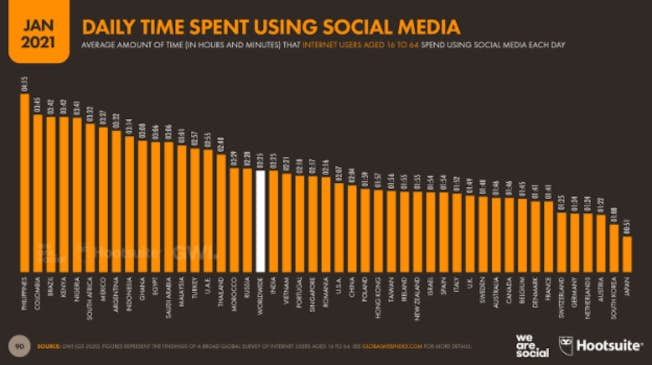
As a whole, Asia loves to consume social media and many countries rank higher than the average worldwide time of 2 hours and 25 minutes. The highest times spent on social channels for Asian countries listed in the report are:
- Indonesia – 3 hours and 14 minutes, ranked 9th
- Malaysia – 3 hours and 1 minute, ranked 13th
- Thailand – 2 hours and 48 minutes, ranked 16th
Interestingly, the continent also has users on the other end of the spectrum, with Japan coming last in social media usage at 51 minutes a day and South Korea at just over an hour.
South America also scores very high in the rankings. Colombia is second in terms of social media usage at 3 hours and 45 minutes with Brazil just 3 minutes behind in third. For Colombia, that’s an 11% increase year on year or 4 million extra users and a 7% yearly increase of 10 million new users in Brazil.
In Colombia, most social media users are between 18-34 years of age active on YouTube, Facebook and Whatsapp with 99% watching online videos. Brazil’s most active market is between 18-44 with a preference for the same three platforms as Colombians.
What are the most popular social media platforms of top countries?
In the top 10 countries that use social media the most, the platforms that prove the most popular differ. Interestingly, YouTube and WhatsApp get more traffic than the biggest network audience wise, Facebook in these countries showing just how popular video and messaging is in 2021.
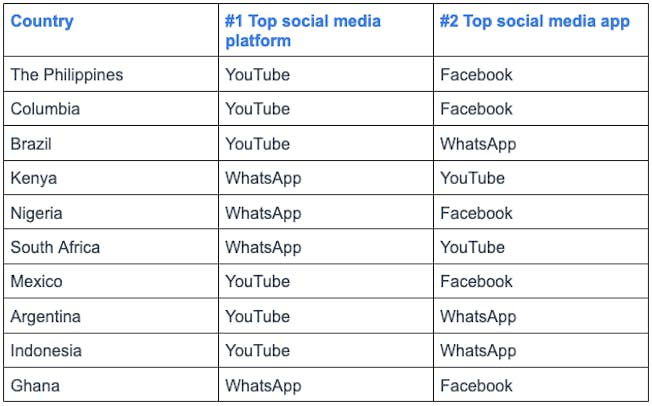
Find out more about marketing on WhatsApp to see what your brand could do on the platform to engage users. Let’s look at the birthplace of social media - the U.S and Canada - when it comes to social media usage.
The U.S and Canada Social Media Use
You would expect North America to rank high in social media usage since it is the birthplace of most social media channels, right? But as evidenced by the astonishing numbers that Asia has for social media and internet use, North America doesn’t come close.
The United States ranks 25th in the world in average social media usage time at 2 hours and 7 minutes. Its neighbor Canada places 38th, at 1 hour and 46 minutes. According to the same Global Digital Report, neither country has many new users to boast. Between 2020 and 2021, social media usage increased by just 4% in the U.S. and 8% in Canada. According to the Pew Research Center, 7 in 10 Americans use social media and that trend has remained stable over the past 5 years. YouTube and Facebook are the most popular platforms, used by 81% and 69% of adults. While YouTube and Reddit were the only channels that saw any recent growth in usage. As expected, there is significant growth on Instagram (71%), Snapchat (65%) and TikTok (50%) with the younger demographic. Nextdoor is a platform to consider if you’re targeting a U.S audience, especially in rural or suburban areas.
In Canada, Facebook reigns supreme, according to research by the Canadian Internet Registration Authority. Seven out of 10 people named Facebook as their most-used app, closely followed by Facebook Messenger. YouTube (55%) also gets a look in while WhatsApp is particularly popular, rising in use by 5% from 2019 to 2020 and Instagram by 2% in the same period. Interestingly the social channels that perform the best in Canada are all Facebook-owned. Social media ranks in Canada as the second most popular online activity, totalling 47% of internet usage after email.
EMEA Social Media Use
In the EMEA region, social media usage varies wildly. A number of African countries spent a lot of time on social media, while many in Europe fall further down the table with Middle Eastern regions falling somewhere in the middle.
Kenya has the highest usage in the EMEA region coming in fourth at 3 hours and 42 minutes followed by Nigeria in fifth at 3 hours and 32 minutes. The growth in Kenya is substantial with 2.2 million more people (25%) using social media in just one year. Nigeria has seen a similar pattern with 22.2% growth equating to 6 million more people accessing social networks. This growth can be linked to an increase in internet penetration and the rise of African social media personalities such as YouTuber Wode Maya and Instagram star, Prince Gyasi.
In the Middle East, two countries spend more than three hours a day on social media - Egypt and Saudi Arabia - coming in 11th and 12th on the list. Turkey and the U.A.E also feature in the top 15 countries at 2 hours and 57 minutes and 2 hours and 55 minutes respectively. According to The Arab Weekly, this rise in usage is due to their adoption by a young demographic with 60% of Millennials being YouTube viewers while WhatsApp saw a 75% penetration. TikTok’s use also rose exponentially in 2021 due to the pandemic and a need to find content that was fun and entertaining with influencers growing their fanbase by 65% in the region.

Lagging behind in social media use is Europe with the highest on the list being Portugal at 2 hours and 18 minutes in 22nd place. This is followed by Romania and Poland at 2 hours and 16 minutes and 1 hour 59 minutes. Austria, the Netherlands and Switzerland bring up the end of the list at just over 1 hour each. While usage may seem low compared to other regions, Europe is a valuable market for brands as Europeans can demand high salaries. Research from BlackRock found that there is €700 billion in savings as a result of the Covid-19 pandemic waiting to be spent in Europe and the U.K. in a phenomenon coined as ‘revenge spending’.
What Social Media is Used For: Country Breakdown
It’s great to know statistics, but what marketers need to dig into is the ‘why’.
When it comes to the reasons that people use the internet, over 51% watch videos, TV shows and movies, 46.3% listen to music and 32% use it for gaming. From these figures, it’s clear that entertainment is front of mind for most people and a huge reason for that is the unstoppable rise of Netflix and other platforms such as Disney+ and Spotify.
Another industry on the rise is gaming which has seen an uptake amongst older generations with two-thirds of internet users that actively play games being between 55 and 64 years of age.
YouTube has also reported that gaming is the biggest breakout genre on their platform. The evolution of games such as Fornite and Roblox, as well as the massive rise of the platform Twitch makes this a sector to keep an eye on. As more people spend time in this space, marketers could take advantage of gaming influencers to build engagement or look at branding opportunities.
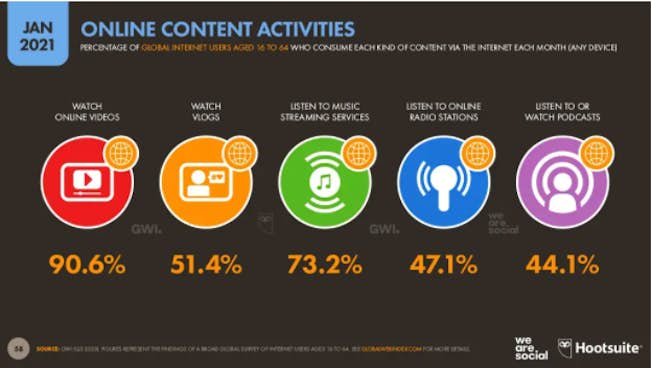
When we look at social media, the top five reasons people use networks are:
- Staying up to date with news and current events
- Entertaining and funny content
- Filling up spare time
- Staying in touch with loved ones
- Sharing photos or videos
And the platforms they are most active on are Facebook, YouTube and WhatsApp, while the social media apps people use most include Facebook, WhatsApp, Instagram, and TikTok.
A contributor to the increase in social media usage is social search. 45% of people look for information about a product or service on a social media channel pre-purchase. This is particularly true for Gen-Z and the Millennial generations.
Interestingly, in using social media for brand research, African countries top the poll - Kenya, Nigeria and Ghana - taking the first 3 places for brand searching on social media followed by Colombia and the Philippines.
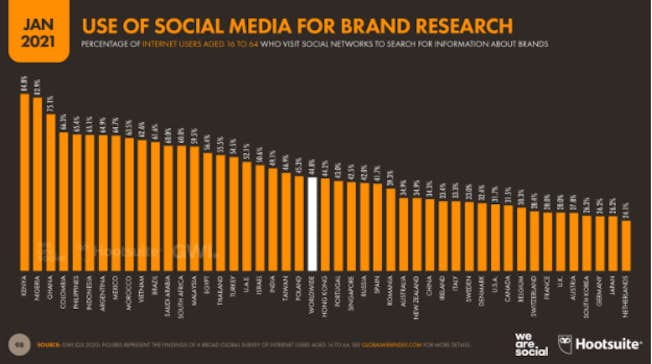
What people look for has also evolved as many now seek out how-to guidance. This is a key insight for marketers and will help guide the platform-specific social media content created to drive traffic.
Localization is also important. While America and Europe (including the UK) may seem like huge territories to target, they only make up 6.4% and 10% of the global population. In comparison, Asia represents 57.4% of the global population.
So look beyond borders when it comes to trends and developments. For example, in China’s ecommerce market, live stream shopping is huge and worth $60 billion a year. The trend is now gaining momentum in India and across Southeast Asia.

User overlaps are not a new phenomenon but are interesting to consider when devising a social media strategy and trying to give your social media team focus.
Facebook users are also active on YouTube and Instagram while TikTok users prefer YouTube as a secondary channel, followed by Facebook. As you can see, YouTube is used by the majority of people so it’s a platform you should consider having a presence and finding out ways to grow your channel. This is especially true when you consider that the amount of people watching videos on YouTube has risen by 6 times in some countries in a year according to App Annie’s State of Mobile 2021 report.
Ultimately, when it comes to social media these networks are no longer just platforms people visit. Social media channels are part of a user’s journey online and permeate many aspects of their lives from connecting with people and brands to seeking out information on products or being inspired by an influencer they see value in.
User-Generated Content (UGC) also plays a huge role in social engagement for brands. For many users, they trust this type of content more than slick advertisements as user generated posts saw a 28% higher engagement rate on social over standard brand posts. This was particularly true during the pandemic as people sought out hopeful and community-building messaging across social. Check out some great examples of user-generated content to see how your brand can capitalize on content created by followers and fans.
Marketers need to see the bigger picture when it comes to social media marketing. It’s not a siloed element, but an integral part of a customer journey. So think about connections, build communities and start conversations that matter.
How has social media usage changed due to COVID-19?
In the face of global lockdowns and remote working, people were limited to what they could do and how to spend their time. A result of this extra time and limited mobility was an increase in social media use. 40% of people now spend more time on social media with the Philippines, India, and South Africa exceeding that global benchmark.
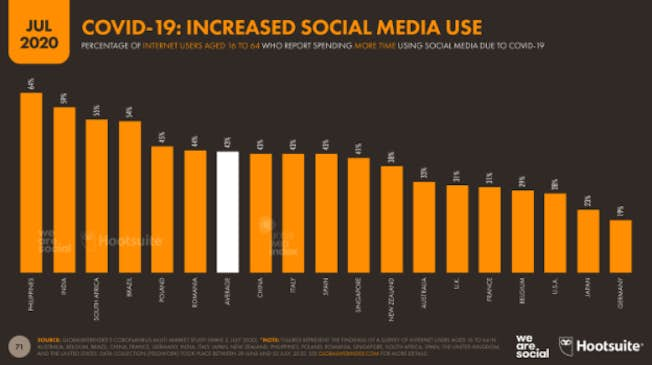
Alongside an upturn in social media use, many sectors have experienced growth. Ecommerce is the big winner as people flocked online to buy products they could no longer go out to buy. As a result, retailers with no online stores bore the brunt of the lockdowns and saw profits plummet.
The sectors that experience a surge in site traffic and revenue include:
- Food and personal care - online food shopping soared as people were limited as to what they could buy within a fixed radius during lockdowns. People also tended to splurge on personal care items or turn to looking after their beauty needs at home.
- Fashion and beauty - With no bricks and mortar stores open, people bought fashion and beauty items online in their droves. ASOS saw its profits triple due to the online sales of casual and sports clothing.
- Digital music - In the absence of festivals or gigs streaming music became the only way to enjoy music. Subscription-based brands such as the audio disruptor Spotify saw a surge in users.
- Toys, DIY and Hobbies - As people looked to entertain themselves at home, they went about improving where they lived. DIY sales went through the roof as gardens were tidied up, walls painted and even home theatres built. Remote schooling also left children with little to do and parents turned to toys and hobbies to stay sane!

In summary, the countries that use social media over three hours a day are:
- The Philippines - 4 hours and 15 minutes
- Columbia - 3 hours and 45 minutes
- Brazil - 3 hours and 42 minutes
- Kenya - 3 hours and 42 minutes
- Nigeria - 3 hours and 41 minutes
- South Africa - 3 hours and 32 minutes
- Mexico - 3 hours and 27 minutes
- Argentina - 3 hours and 22 minutes
- Indonesia - 3 hours and 14 minutes
- Ghana - 3 hours and 8 minutes
- Egypt - 3 hours and 6 minutes
- Saudi Arabia - 3 hours and 6 minutes
- Malaysia - 3 hours and 1 minute
Get ahead with a social media and marketing course
Learn how to get the most out of your social media channels with a local and global audience. Understand every aspect of social media from social research to customer service and strategy. From Facebook to YouTube to TikTok, DMI’s certified social media marketing course will teach you everything you need to build meaningful connections with your customers.
First published January 2019, Updated November 2021
- Categories:
- Articles
- Social Media Marketing
Upgrade to Power Membership to continue
your access to thousands of articles, toolkits, podcasts, lessons and much much more.
Become a Power Member- Login
- View Courses
- - - -
- Courses
- Resources
- - - -
- My Account
- Change Password
- Logout




